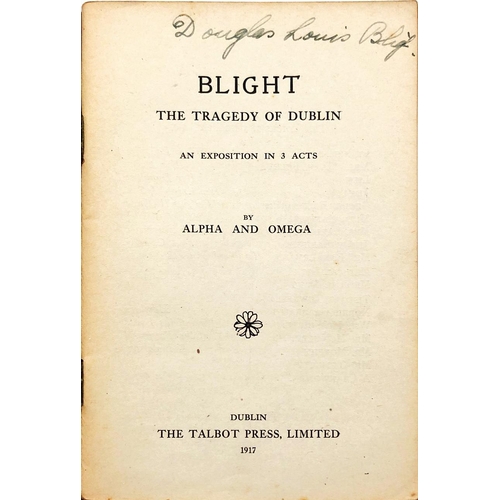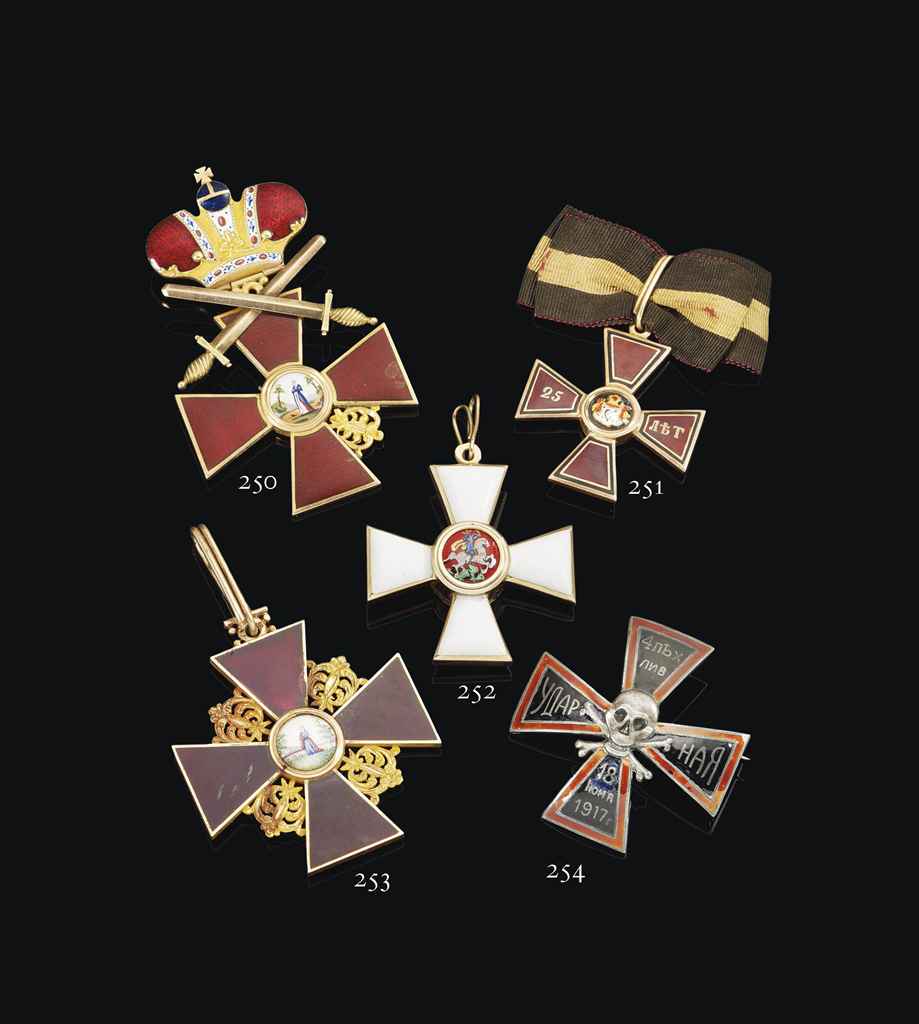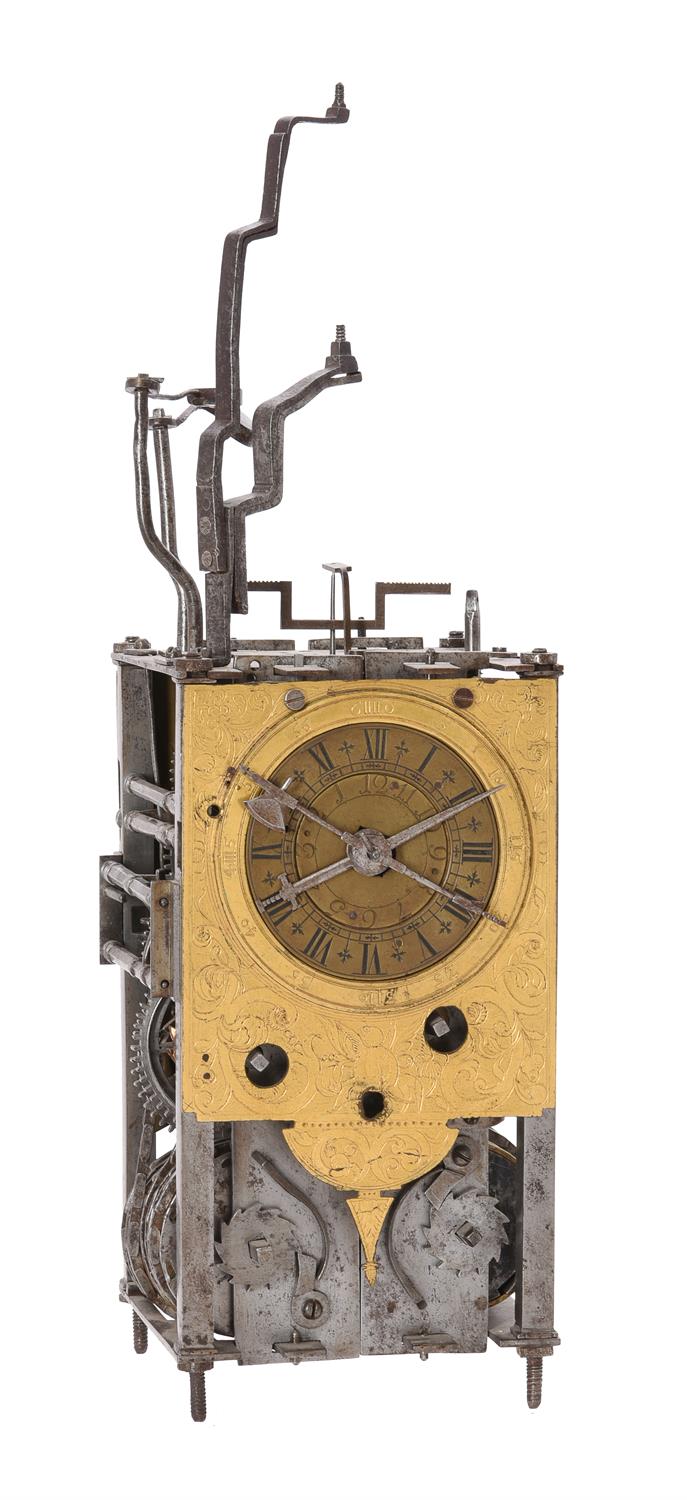A very rare second quarter of the 19th century boxwood-strung ebonised travel timepiece with alarm and quarter repeatWestwood, Princes Street, Leicester Square, London The arched case surmounted by a recessed folding campaign-style brass handle over a ripple moulding to the top and bottom, with geometric boxwood line inlay, supported by four brass ball feet (the two rearmost spheres with flattened backs). The 4inch signed white enamel Roman and Arabic dial with Breguet style hands and tapering alarm-setting hand, within a cast concave bezel and with three blued steel hands. The movement consisting of three brass plates united by plain turned pillars, the front pair housing the going train with maintaining power to a chain fusee terminating in an English underslung lever escapement set below a heavy plain brass balance with three timing screws; the alarm and repeat trains both set within the rear pair of plates, the former with brass double-headed hammer acting on a large bell above, the hours and quarters repeated via one large and one small brass hammer sounding on a single bell set on the top plate. All the wheelwork protected by pinned side doors and a screw-on rear plate signed Westwood, Princes Street, Leicester Square, LONDON with silvered regulation dial above. Ticking, repeating and alarm operational. With handle recessed 23.5cms (9.25ins) high; 28cms (11 ins) high with handle raised. FootnotesRobert Westwood was born in 1784. Although there is no record of his apprenticeship, there is a James Westwood who was apprenticed to William Rose in 1771. James was from Westminster, and his late father, John, had been a solicitor. Given the dates, it has been suggested that this James Westwood was Robert's father, the latter taking his son as an apprentice when he was old enough. In 1818, Robert married Mary Priestman, who was about 22 years his senior, and promptly moved in to 23 Prince's Street, a leasehold property she owned. They went into business together; Westwood was responsible for the watches and clocks, and Priestman managed the jewellery side of the business. It is unknown if she had served an apprenticeship as a jeweller, or possibly was taught by a relative. In July 1822, the property was burgled by William Reading who stole 200 watches, with a combined value of £600, 10 watch chains, with a value of £20, and a number of miscellaneous items and some money. The total value stolen, including the watches and chains, was £652, which suggests that the couple had quite a prosperous business. The burglar apparently had a history of petty theft, though this was the first time he had been caught and prosecuted for it. He was eventually found guilty and executed. In 1824, a trade card was produced for Westwood, which showed he was still trading from 23 Prince's Street and also described him as a 'chronometer, watch and clock maker'. The card also referred to the recent, 1821-1823, Polar Expedition of William Parry stating that the only two chronometers on the expedition which ran without fail were owned by the voyage's two surgeons, and were manufactured by Westwood. The card also claimed that several officers for the current 1824-1825 expedition had requested Westwood chronometers. Five years after the trade card was published, Westwood took out a patent for an eight-day pocket watch. The larger barrel was accommodated by splitting the train over two planes, which meant that the watch would be no larger than a standard pocket watch. This idea was used throughout the 20th century to make increasingly smaller and more delicate wristwatches, which would still run for the standard 30 hours. The Duke of Sussex, Augustus Frederick, was so taken with Westwood's eight-day watch that he had one commissioned. It was sold at auction, after his death in 1843, and was described in the catalogue as being in a gold, engine-turned case, and numbered 50. It was bought for £38 10s. This was the only device of Westwood's in the Duke possess
A very rare second quarter of the 19th century boxwood-strung ebonised travel timepiece with alarm and quarter repeatWestwood, Princes Street, Leicester Square, London The arched case surmounted by a recessed folding campaign-style brass handle over a ripple moulding to the top and bottom, with geometric boxwood line inlay, supported by four brass ball feet (the two rearmost spheres with flattened backs). The 4inch signed white enamel Roman and Arabic dial with Breguet style hands and tapering alarm-setting hand, within a cast concave bezel and with three blued steel hands. The movement consisting of three brass plates united by plain turned pillars, the front pair housing the going train with maintaining power to a chain fusee terminating in an English underslung lever escapement set below a heavy plain brass balance with three timing screws; the alarm and repeat trains both set within the rear pair of plates, the former with brass double-headed hammer acting on a large bell above, the hours and quarters repeated via one large and one small brass hammer sounding on a single bell set on the top plate. All the wheelwork protected by pinned side doors and a screw-on rear plate signed Westwood, Princes Street, Leicester Square, LONDON with silvered regulation dial above. Ticking, repeating and alarm operational. With handle recessed 23.5cms (9.25ins) high; 28cms (11 ins) high with handle raised. FootnotesRobert Westwood was born in 1784. Although there is no record of his apprenticeship, there is a James Westwood who was apprenticed to William Rose in 1771. James was from Westminster, and his late father, John, had been a solicitor. Given the dates, it has been suggested that this James Westwood was Robert's father, the latter taking his son as an apprentice when he was old enough. In 1818, Robert married Mary Priestman, who was about 22 years his senior, and promptly moved in to 23 Prince's Street, a leasehold property she owned. They went into business together; Westwood was responsible for the watches and clocks, and Priestman managed the jewellery side of the business. It is unknown if she had served an apprenticeship as a jeweller, or possibly was taught by a relative. In July 1822, the property was burgled by William Reading who stole 200 watches, with a combined value of £600, 10 watch chains, with a value of £20, and a number of miscellaneous items and some money. The total value stolen, including the watches and chains, was £652, which suggests that the couple had quite a prosperous business. The burglar apparently had a history of petty theft, though this was the first time he had been caught and prosecuted for it. He was eventually found guilty and executed. In 1824, a trade card was produced for Westwood, which showed he was still trading from 23 Prince's Street and also described him as a 'chronometer, watch and clock maker'. The card also referred to the recent, 1821-1823, Polar Expedition of William Parry stating that the only two chronometers on the expedition which ran without fail were owned by the voyage's two surgeons, and were manufactured by Westwood. The card also claimed that several officers for the current 1824-1825 expedition had requested Westwood chronometers. Five years after the trade card was published, Westwood took out a patent for an eight-day pocket watch. The larger barrel was accommodated by splitting the train over two planes, which meant that the watch would be no larger than a standard pocket watch. This idea was used throughout the 20th century to make increasingly smaller and more delicate wristwatches, which would still run for the standard 30 hours. The Duke of Sussex, Augustus Frederick, was so taken with Westwood's eight-day watch that he had one commissioned. It was sold at auction, after his death in 1843, and was described in the catalogue as being in a gold, engine-turned case, and numbered 50. It was bought for £38 10s. This was the only device of Westwood's in the Duke possess





.jpg)









Testen Sie LotSearch und seine Premium-Features 7 Tage - ohne Kosten!
Lassen Sie sich automatisch über neue Objekte in kommenden Auktionen benachrichtigen.
Suchauftrag anlegen